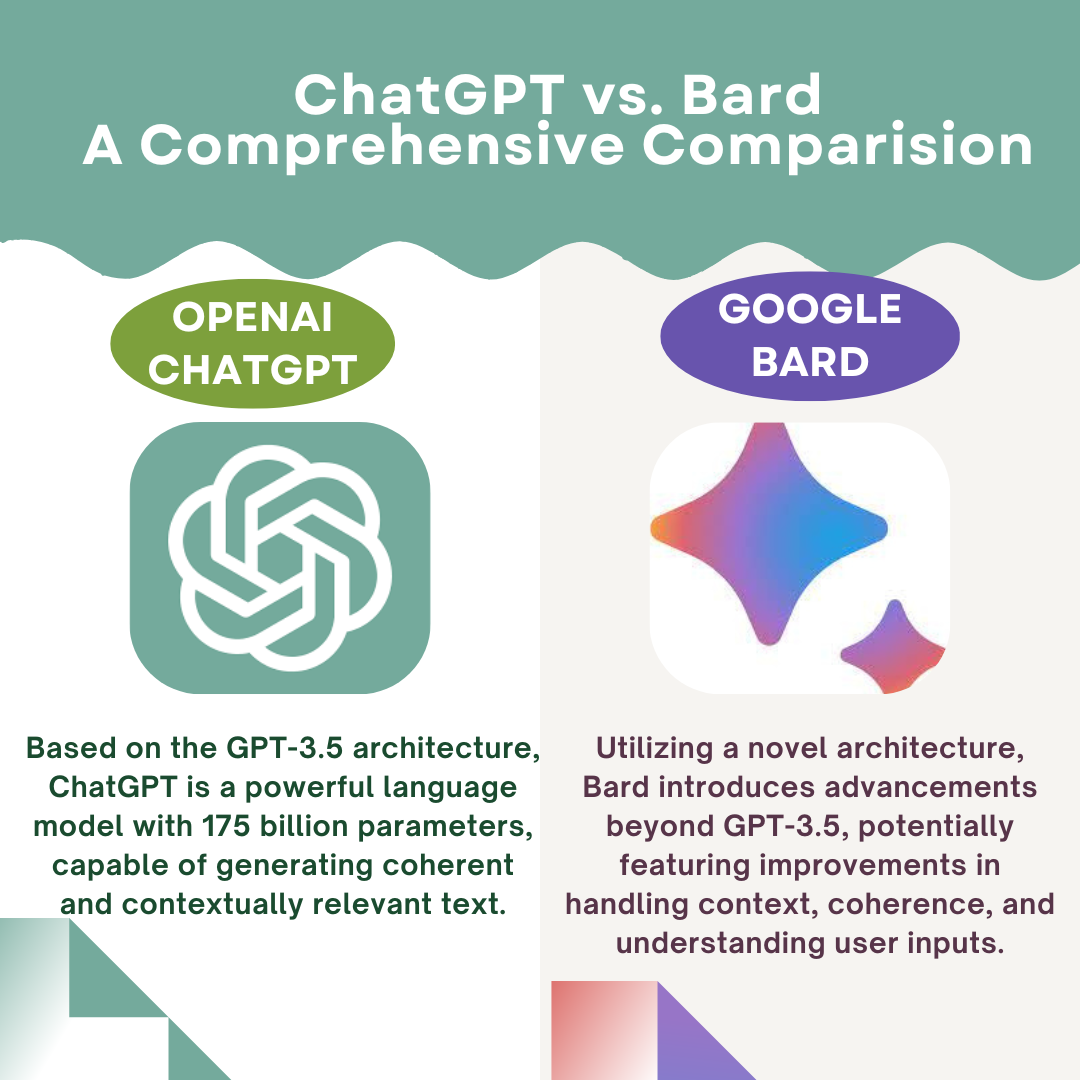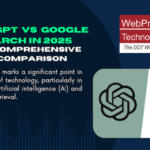Introduction
Both ChatGPT and Bard are advanced language models developed by OpenAI, aiming to excel in natural language understanding and generation tasks. In this comparison, we'll delve into their differences across several key dimensions.
Model Architecture
ChatGPT: Based on the GPT-3.5 architecture, ChatGPT is a powerful language model with 175 billion parameters, capable of generating coherent and contextually relevant text.
Bard: Utilizing a novel architecture, Bard introduces advancements beyond GPT-3.5, potentially featuring improvements in handling context, coherence, and understanding user inputs.
Text Generation Quality
One of the primary benchmarks for language models is the quality of generated text.
Coherence and Contextual Understanding
ChatGPT: Excels in maintaining context and generating coherent responses, but may sometimes produce responses that lack deep understanding of specific queries.
Bard: Aims to improve upon contextual understanding, providing more nuanced and contextually relevant responses. The architecture might be designed to enhance coherence and reduce instances of generating nonsensical or irrelevant text.
Creativity and Originality
ChatGPT: Known for its creative outputs, capable of generating unique and contextually appropriate content.
Bard: Expected to surpass ChatGPT in terms of creativity, potentially introducing novel ways of expressing ideas and generating original content.
Fine-Tuning and Customization
Fine-tuning capabilities allow users to tailor the model to specific tasks or domains.
Adaptability
ChatGPT: Offers fine-tuning capabilities, allowing users to adapt the model to various applications, although some challenges exist in achieving precise control over outputs.
Bard: May introduce advancements in fine-tuning capabilities, enabling users to achieve more precise control and customization, catering to a broader range of specialized applications.
Domain-Specific Performance
ChatGPT: Performs reasonably well in domain-specific tasks with fine-tuning but may exhibit limitations in highly specialized contexts.
Bard: Expected to show improvements in domain-specific performance, potentially outperforming ChatGPT in tasks that demand a deep understanding of specific domains.
Handling Ambiguity and Vagueness
Both models are evaluated in their ability to handle ambiguous or vague queries.
Ambiguity Resolution
ChatGPT: Demonstrates a moderate ability to resolve ambiguity but may struggle with highly ambiguous queries.
Bard: Aims to improve ambiguity resolution, leveraging advancements in its architecture to provide clearer and more precise responses to ambiguous inputs.
Vagueness Handling
ChatGPT: Sometimes produces vague responses when faced with unclear queries, requiring additional prompts for clarification.
Bard: Expected to exhibit enhanced vagueness handling, potentially reducing the need for repeated prompts and providing more accurate responses in ambiguous scenarios.
Ethical Considerations and Bias Mitigation
Addressing ethical concerns and mitigating biases in language models is crucial for responsible AI development.
Bias Mitigation
ChatGPT: Faces challenges in completely eliminating biases and may inadvertently generate biased content.
Bard: Aims to incorporate improved mechanisms for bias detection and mitigation, contributing to a more ethical and unbiased language generation.
Ethical Use Cases
ChatGPT: Encourages ethical use but requires users to be mindful of potential misuse and ethical considerations.
Bard: May introduce enhanced ethical guidelines and features to discourage misuse, promoting responsible and ethical use of the model.
User Interaction and Interface
The user experience and interaction with the models play a vital role in their practical utility.
Responsiveness
ChatGPT: Generally provides prompt and responsive interactions, with minimal latency in generating responses.
Bard: Aims to maintain or improve responsiveness, ensuring a seamless and efficient user experience.
User-Friendly Interface
ChatGPT: Interacts through a user-friendly text-based interface, accessible to a wide range of users.
Bard: Expected to retain or enhance user-friendliness, with potential improvements in understanding user inputs and providing more user-centric interactions.
Table: Summary of Differences
| Aspect | Open AI ChatGPT | Google Bard |
| Model Architecture | GPT-3.5 | Novel architecture (beyond GPT-3.5) |
| Text Generation Quality | Coherent, contextually relevant | Improved coherence, deeper understanding |
| Fine-Tuning and Customization | Fine-tuning capabilities | Advanced fine-tuning with improved customization |
| Handling Ambiguity and Vagueness | Moderate ambiguity resolution | Enhanced ambiguity resolution, reduced vagueness |
| Ethical Considerations and Bias Mitigation | Challenges in bias mitigation | Improved bias detection and mitigation |
| User Interaction and Interface | Responsive and user-friendly | Maintained or improved responsiveness and interface |
| Pricing | ChatGPT 3.5 is free for users. But , ChatGPT, GPT 4, is a paid subscription for $20/month. | Free for all as of now. |
| Developer | OpenAI | Alphabet/Google |
| Image generation | Cannot generate images | Can generate images |
| Internet access | No | Yes |
How Bard and ChatGPT Boost Speed and Efficiency in Different Work Domains:
ChatGPT
- Content Summarization:
Application: ChatGPT's proficiency in summarizing text makes it invaluable for automating content summarization tasks. It can be applied in fields such as journalism, research, and content curation, where quick and accurate summarization of lengthy texts is crucial for efficiency.
- Drafting and Writing Assistance:
Application: ChatGPT's text generation capabilities make it a valuable tool for drafting content efficiently. It can be employed in writing emails, reports, or articles, streamlining the content creation process.
- Code Generation and Review:
Application: In software development, ChatGPT can be used to generate code snippets and assist in code reviews. This application can significantly accelerate the coding process and improve code quality.
- Customer Support Automation:
Application: ChatGPT can be integrated into customer support systems to handle routine queries, providing quick and accurate responses. This speeds up customer interactions and allows human agents to focus on more complex issues.
Bard:
- Real-time Information Retrieval:
Application: Bard's strength in providing up-to-date information makes it ideal for applications requiring real-time data. This includes fields such as news reporting, financial analysis, and data-driven decision-making.
- Conversational Interfaces:
Application: Bard's architecture is well-suited for creating conversational interfaces in applications like chatbots. This can enhance the efficiency of customer service, virtual assistants, and other interactive platforms.
- Medical Information and Research:
Application: In the medical field, Bard can be utilized to stay current with the latest research and advancements. This is crucial for healthcare professionals who need quick access to relevant information for diagnosis and treatment.
- Education and Training:
Application: Bard's conversational abilities can be harnessed for educational purposes, providing interactive and engaging learning experiences. It can be applied in virtual classrooms, training simulations, and e-learning platforms to improve learning efficiency.
Comparative Analysis Bard and ChatGPT:
Overlap in Content Creation: Both models can contribute to content creation, but ChatGPT's strength lies in generating and summarizing textual content, while Bard focuses on real-time information and conversational interfaces.
Complementary Use Cases: ChatGPT and Bard can be complementary in certain scenarios. For example, ChatGPT can be used to draft content, and Bard can be integrated for fact-checking or adding the latest information.
Task Complexity: ChatGPT may excel in tasks requiring a deep understanding of context, while Bard's efficiency shines in tasks that demand real-time updates and interactive conversations.
Key Takeaways…
ChatGPT and Google Bard stand out as formidable AI chatbots, each showcasing unique strengths in content generation. While ChatGPT distinguishes itself with its exceptional ability to summarize text, Bard takes the lead in providing accurate and current information when responding to questions. This divergence in expertise is rooted in their respective underlying architectures—ChatGPT harnesses the power of GPT-3.5, whereas Bard relies on Google's innovative LaMDA model.
ChatGPT's forte lies in its proficiency in condensing information into concise and coherent summaries. Leveraging the GPT-3.5 architecture, ChatGPT excels in processing and distilling textual content, making it particularly adept at tasks that demand a comprehensive understanding of the input data and the ability to present it succinctly.
On the other hand, Bard, powered by Google's LaMDA, takes center stage in the realm of conversational AI. Its specialization in providing responses with the latest information positions it as an ideal choice for users seeking real-time and up-to-date knowledge. The LaMDA architecture, designed by Google, enhances Bard's conversational capabilities, allowing it to excel in delivering timely and contextually relevant answers to user queries.
The contrasting strengths of these AI chatbots make them complementary tools, catering to distinct use cases. ChatGPT's prowess in text-based processing is well-suited for applications requiring in-depth understanding and summarization of content. Meanwhile, Bard's proficiency in conversational tasks makes it an invaluable resource for users seeking immediate and precise information.
ChatGPT and Google Bard emerge as powerful AI chatbots, each carving its niche in content generation. Whether prioritizing summarization or real-time information retrieval, users can leverage these platforms strategically based on their specific requirements.
December 13, 2023





